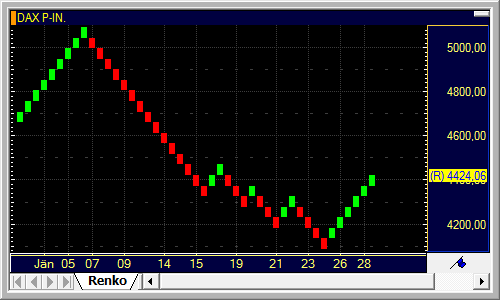Renko charts are plotted with so-called bricks (rising or falling boxes). They are similar to Point and Figure charts, as they also do not show a linear representation of time and are used with different (configurable) brick sizes.

Every brick on a Renko chart has the same size, independent of rising or falling prices. A new brick is drawn when the price of a symbol changes by more than the brick size in the chosen period of time (for example during a day for daily charts, or 10 minutes for intraday charts – see also Changing the Data Compression). If prices change several times the brick size, then as many bricks as needed to show the price movement are plotted on the chart for this period. If the price change is smaller than the brick size, then nothing is drawn for this period. The appropriate brick size is initially determined automatically, but can later be changed in the chart properties.
A movement into the opposite direction (reversal) takes place when the price moves one brick down from the previous (rising) brick. Unlike Point and Figure or Three Line Break charts, the Renko chart does not have additional reversal conditions. Therefore, a reversal can happen faster than in those chart types, but there can be also more false signals. Renko charts are primarily used in trending markets.
Renko charts were originally developed and used in Japan. To find more detailed information about them, see for example Steve Nison: Beyond Candlesticks. John Wiley & Sons, 1995.
▪ Right-click on the Renko chart and choose Properties.
▪ On the left side of the dialog, select the name of the chart pane, the name of the symbol and then Display. For example: Pane 1 > DAX > Display.
▪ On the right side of the dialog, choose Price Step to enter the absolute value that the price has to move before a new brick is added to the chart, or choose Percentage to enter the brick size as a percentage.
Note You can save your settings as default for the current symbol and data compression by clicking the Set As Default button.